Today we will talk about a new gadget from MSI, which the manufacturer itself mysteriously calls on its website nothing less than a “magnetic portable drive”. This term gives free rein to the imagination and involuntarily hints at a HDD – a storage device on magnetic hard disks, in other words, a portable hard drive. But in reality, MSI has not released it. The company’s new product, which was named Datamag 20Gbps, is an external SSD. The addition of “20Gbps” in this case specifies the type of interface it uses – USB 3.2 Gen 2×2, which has a throughput of 20 Gbit/s. But the question remains: why is this external SSD called “magnetic”? The answer to it is simple to the point of ugliness – because magnets are built into the case of this drive, which allow it to be attached to steel surfaces and more.
For those users who have to move large amounts of data from one place to another, external SSDs are a must-have gadget. Therefore, many people produce such drives, and this niche is full of products from different companies. However, this did not stop MSI, and it expanded the range of its flash memory-based products in this direction. Datamag 20Gbps became the first portable drive from MSI, and it appeared only at the end of last year. How seriously the company is going to deal with such products in the future is still unclear, and whether Datamag 20Gbps will receive any development will probably depend on how successful the first-born turns out to be.

But at the same time, the appearance of an external SSD in the MSI range can hardly be called a surprise. The company has been offering internal solid-state drives since 2021 and has become a fairly noticeable player in the market during this time. At the same time, the strategy chosen by MSI is simple: it signed up as a Phison partner and one after another stamps out adapted versions of reference drives on this developer’s controllers.
Datamag 20Gbps is no exception to this rule. It is also based on one of Phison’s designs. But in this case, MSI still had to put in more effort, since the consumer qualities of external SSDs are determined not only by the filling, but also by their external design, and the company’s own engineers are responsible for it.
In this review, we will see how successfully MSI managed to create a suitable frame for another publicly available Phison platform. For a detailed acquaintance, our lab received the junior version of Datamag 20Gbps with a capacity of 1 TB, and we will check whether MSI’s “magnetic portable storage device” can compete for the attention of consumers.
⇡#Specifications
MSI Datamag 20Gbps comes in three versions – 1, 2 or 4 TB, which differ only in capacity. According to the specifications, performance does not scale with capacity, which distinguishes this external SSD from internal drives, where speeds increase with capacity.
As follows from the specifications of the drive, as well as from its name, it is designed to work via a USB 3.2 Gen 2×2 port with a theoretical throughput of 20 Gbps. In theory, such a port allows you to pump data at a speed of up to 2 GB/s. The passport characteristics of the Datamag 20Gbps do not promise such indicators, and this means that the performance of this external SSD is limited not by the interface bandwidth, but by its internal device. For this reason, the MSI drive is far from the fastest external SSD with a USB 3.2 Gen 2×2 port on the market. However, it has other undeniable advantages.
⇡#About MSI Datamag 20Gbps in detail
Since an external SSD is a device that travels with the user and is often seen, the design is of great importance. MSI chose a square prism shape for the Datamag 20Gbps with a side of 66 mm and a height of 13 mm. Three of the four corners of this prism are truncated, which makes it look more like a puck, and the fourth corner is made in the form of an eye, by which the drive can be hung on, for example, a bunch of keys or a backpack. It would seem appropriate to add a carabiner to such a drive, but it is not included. Nevertheless, in terms of appearance, the Datamag 20Gbps will give a hundred points ahead of any USB container for M.2 SSD from AliExpress, which are used by many to create fast external drives.
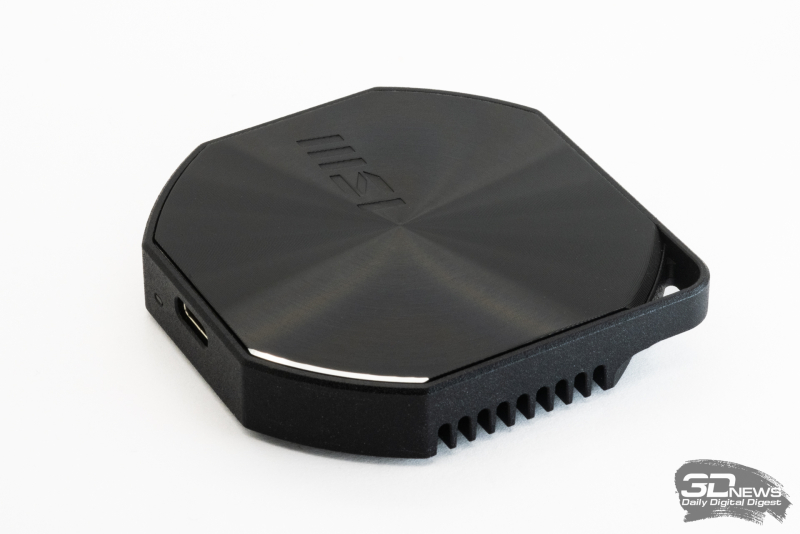
The Datamag 20Gbps case is designed to reliably protect the electronics from any mechanical impacts. It is made of fairly thick metal, similar to an aluminum alloy, and it is unlikely to break it accidentally. The elegant plate with the MSI logo covering the front side of the drive is nothing more than a decorative element. It is simply glued to the solidly screwed case with thick walls, just like the rubber ring glued to its back side, which is needed to prevent the SSD from sliding when it is placed on any surface. The only thing that the drive is clearly missing in its equipment is protection from dust and moisture, but for some reason MSI did not provide it.
The USB port on the Datamag 20Gbps is a USB-C connector, which is located on one of the sides of the prism-shaped case. Next to the port is a small eye of a not very bright white LED. It serves as an activity indicator – when accessing the drive, the LED blinks.

Despite the lack of a carabiner in the kit, it is difficult to reproach MSI for not thinking well about the set of accessories included with the SSD. In the box with the device, you can find a comprehensive set of accessories for connecting the drive to a computer, which includes two flat cables with USB-C connectors on both ends and an adapter from USB-A to USB-C, which should cover all scenarios for interfacing Datamag 20Gbps with various systems. The included cables vary in length: the first is 36 cm long, and the second is half as long. Judging by the size of these wires, we can assume that MSI sees the main users of its external drive as owners of smartphones, tablets and laptops, but not desktop PCs, which do not always have high-speed USB ports on the front panel. However, regular USB cables are suitable for Datamag 20Gbps, so buying an additional wire of the required length is not such a problem.
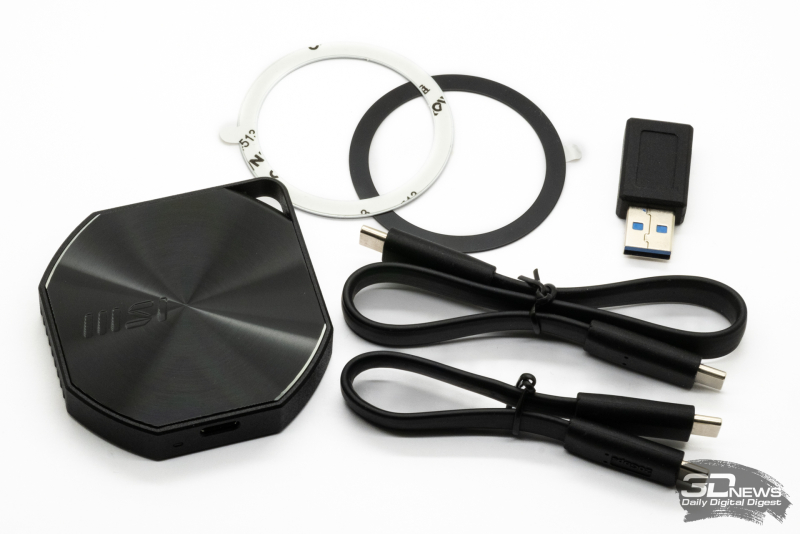
In addition, the MSI drive comes with two steel rings, coated with an adhesive layer on one side. The thing is that the base of the drive has neodymium magnets built into it, which can be used to attach it to a surface with ferromagnetic properties. MSI assumes that this will allow the SSD to be magnetized to the laptop or smartphone to which it is connected, which will make it more convenient to use “on the fly”.
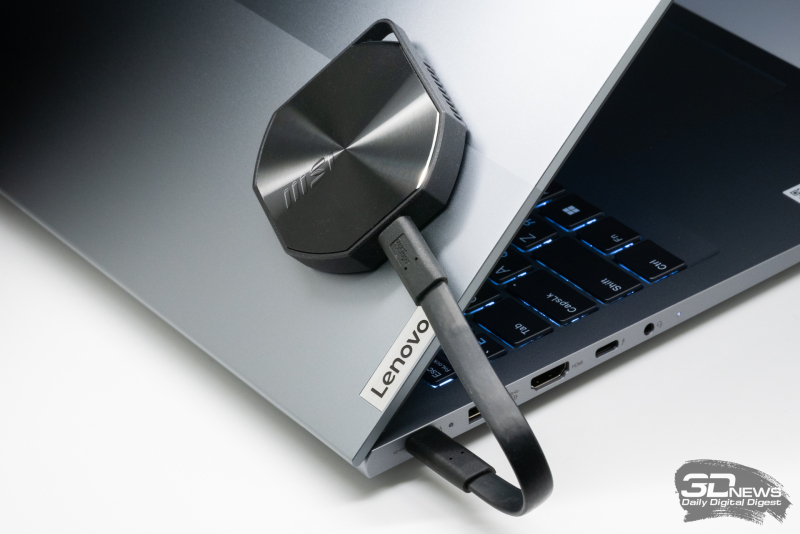
However, not all devices have iron, nickel or steel cases. It is for these cases that MSI has provided steel rings. Want to attach Datamag 20Gbps to the cover of an aluminum laptop or plastic smartphone – stick a steel ring on it, and the problem is solved. At the same time, MSI has thought about how to make such a ring not look completely alien when placed on a smartphone or laptop: the rings included in the kit have different colors – white and black.
Separately, we note that owners of the latest versions of the iPhone will not have to stick anything at all. The placement of magnets at the base of the drive is selected so that Datamag 20Gbps is fully compatible with the standard Apple MagSafe magnetic mount.
Although the idea of a drive that “sticks” to computers and gadgets looks interesting, it is worth noting that placing powerful magnets near working electronic devices is not always beneficial for them. For example, we would not advise hanging a magnetic drive on a PC case that has classic HDDs inside. Owners of Datamag 20Gbps should try not to forget about this point.
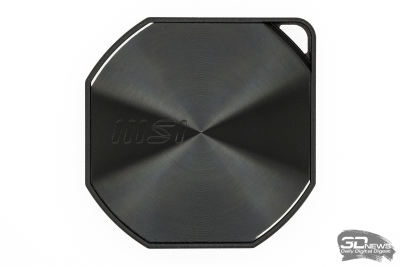
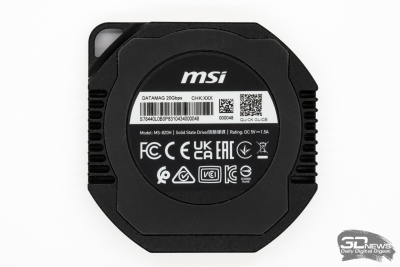
Despite the fact that the drive’s case has some ribs that are supposedly designed for heat dissipation, in reality this is more of a decoration. The fact is that when disassembling the Datamag 20Gbps, it turns out that the board and electronic components located inside do not touch the case at all.
The printed circuit board that serves as the basis of the external SSD from MSI simply “hangs” inside the aluminum shell on several legs-stops. Frankly speaking, the lack of thermal pads in the design is quite upsetting and surprising, because the manufacturer writes on its website about “an aluminum case with effective cooling.” Such thermal pads would clearly not be superfluous, because the drive controller heats up quite noticeably during operation. But more on that below.
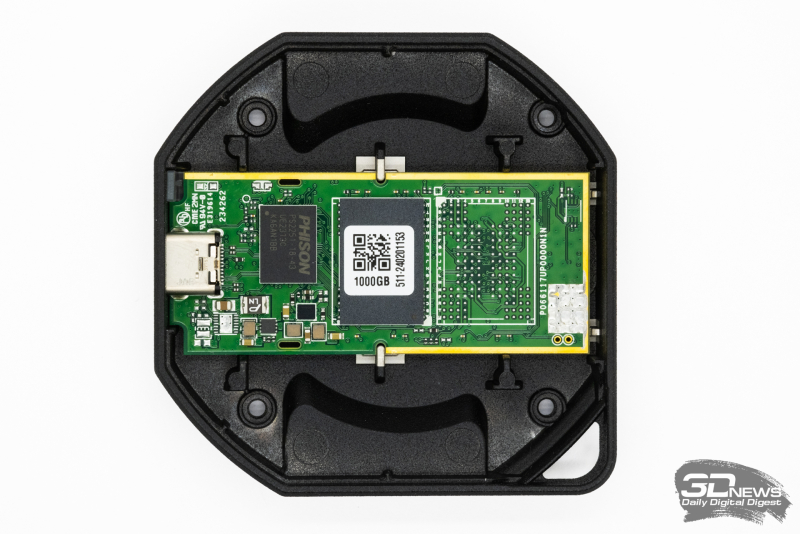
The board itself is also interesting – it shows that the Datamag 20Gbps’s internals are not unique at all. The drive is based on the PS2251-18 (U18) controller and a reference board based on it, manufactured to order and under the control of Phison. In other words, when releasing the external drive, MSI acted in exactly the same way as with internal SSDs. It turned to Phison for ready-made electronics, and took on the design and manufacture of the case, care for the delivery set, marketing, etc.
The use of the Phison U18 controller in the Datamag 20Gbps is quite good news. This is a time-tested UFD solution for external SSDs with native and direct support for the USB 3.2 Gen 2×2 interface. The U18 controller offers two channels for connecting flash memory and, provided that it is equipped with the appropriate TLC 3D NAND chips, is capable of delivering performance of up to 1.5-1.6 GB/s. In this case, the flash memory array is composed of 128-layer SK hynix crystals with a capacity of 1 Tbit each. Here we are looking at a 1 TB drive, and in this drive, eight of these crystals fit inside two chips located on different sides of the board.
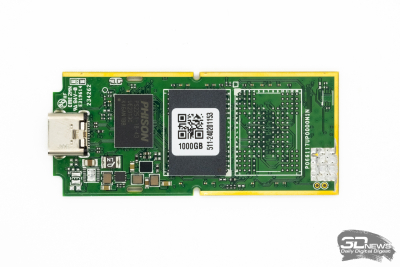
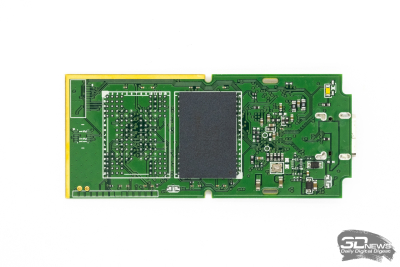
Apart from the controller and flash memory, there is nothing interesting on the SSD board. Since we are talking about an external drive, which is designed to rewrite files back and forth and is not intended for intensive small-block loads, no DRAM buffer is provided in it. This should not affect the speed under normal conditions, plus the design without DRAM eliminates the problems with transferring information from the buffer to the flash memory when suddenly disconnected from the USB port through which the drive is supplied with power.
⇡#Testing
We tested the performance of the MSI Datamag 20Gbps 1TB in a system built on a Core i9-14900K processor and an ASUS ROG Maximus Z790 Apex motherboard. This platform is good because it has USB 3.2 Gen 2×2 and USB 3.2 Gen 2 ports implemented directly by the chipset, rather than separate controllers that can introduce additional delays and affect peak throughput. To achieve maximum performance, the drive was formatted with the NTFS file system.
However, it should be borne in mind that full use of external SSDs with smartphones and tablets on Android and iOS, as well as with computers on macOS, is only possible with the exFAT file system, which is a little slower. However, most of these devices also do not have USB ports with a throughput of 20 Gbps, and even the iPhone 16 Pro Max is equipped with only a 10 Gbps port. Therefore, one way or another, MSI Datamag 20Gbps is capable of developing the maximum data transfer speed only when working with a PC.
First of all, we assessed the peak performance of the drive in question using the CrystalDiskMark synthetic test.
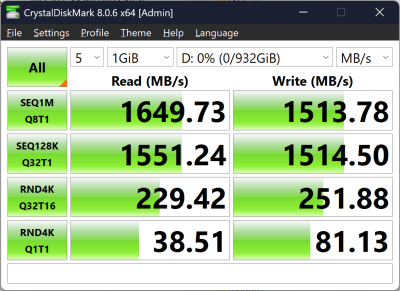
Connection via USB 3.2 Gen 2×2
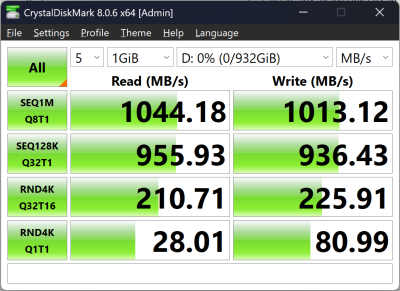
Connection via USB 3.2 Gen 2
When connected to a fast USB 3.2 Gen 2×2 port, the tested MSI drive works as it should. It really delivers speeds of 1.6 GB/s when reading and 1.5 GB/s when writing. If connected to a USB 3.2 Gen 2 port, these values drop to 1 GB/s, which is quite natural, since the throughput of this interface is only 10 Gbps.
The obtained results look pretty good for an external SSD, but to be fair, it should be noted that the MSI Datamag 20Gbps is not among the fastest portable SSDs with a USB 3.2 Gen 2×2 interface. The current leaders are solutions built on the SMI SM2320 controller (for example, the Adata SD810, Crucial X10 Pro or Kingston XS2000) – their peak speeds reach 2 GB/s.
However, it is absolutely impossible to call the MSI Datamag 20Gbps not fast enough. For example, you can fill the entire terabyte provided by this SSD with files in just half an hour. Moreover, the first 24 GB of data are written to it at a higher speed due to SLC caching. However, the maximum speed observed when copying files to the Datamag 20Gbps using Windows is somewhat lower than the peak values and is about 1.05 GB/s.
To get a more complete picture, we monitored the MSI Datamag 20Gbps continuous file copy speed until its capacity was completely depleted when connected to the fastest USB 3.2 Gen 2×2 interface. What the performance looks like in this case is shown in the graph below. It shows three curves corresponding to testing under different conditions: when the drive is completely empty; when it is pre-filled with data halfway; and when only a quarter of the original capacity is free on it.
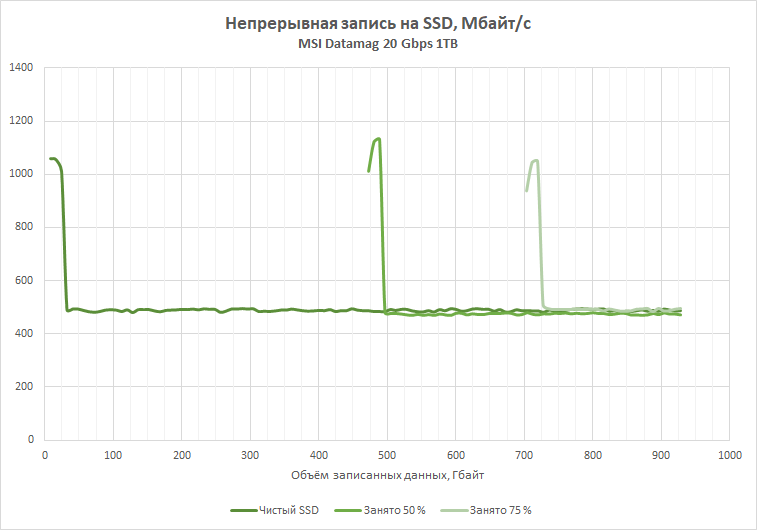
It is easy to notice that the SLC cache of MSI Datamag 20Gbps is static. Its volume is about 24 GB, and it does not depend on the initial filling of the SSD. It is these 24 GB that can be written to Datamag 20Gbps at a speed slightly higher than 1 GB/s. If the volume of the copied folder is larger, then after writing the first 24 GB the speed drops by about half – to 490 MB/s. And such copying performance is maintained until the process is interrupted or the drive runs out of free space.
The following graph shows the speed of copying files using Windows in the opposite direction – from a data-filled MSI Datamag 20Gbps.
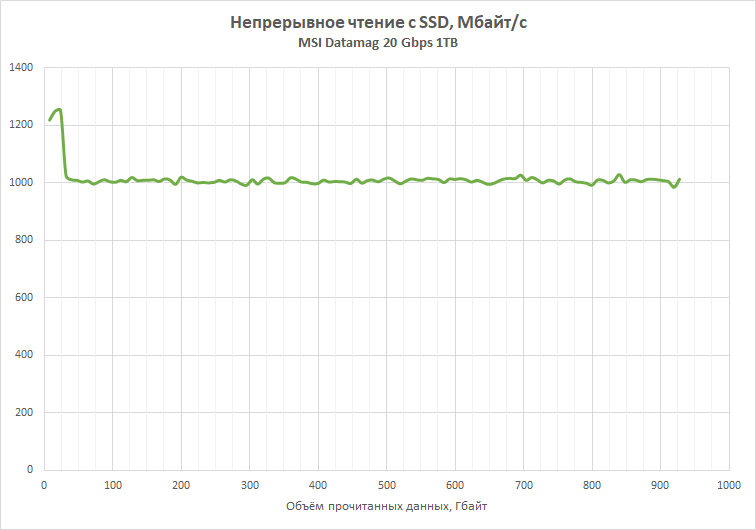
There are no surprises here. The read speed remains at 1 GB/s across the entire drive. With one exception: if the copied files are in the SLC cache, their reading may be faster, and the speed will be 1.2 GB/s. This is possible if you read from the SSD the files that were written to it last.
It is curious that in real file copying in Windows the speed of MSI Datamag 20Gbps turns out to be almost twice lower than the theoretical throughput of the interface through which it works. This is partly due to the limitations of the dual-channel Phison U18 controller, partly due to the peculiarities of file operations in the Microsoft OS. This means that the prefix “20Gbps” in the name of the SSD in question is just a marketing mantra, and not a reflection of real performance.
Separately, we have verified that the MSI Datamag 20Gbps supports the TRIM command via USB. This means that its initial performance will be maintained during long-term use. However, it should be noted that by default, TRIM only works with the NTFS file system.
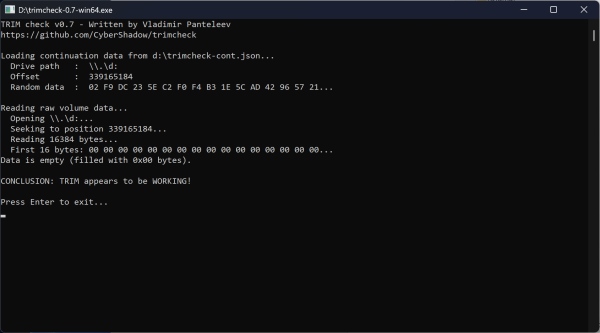
However, in the case of exFAT, you can use third-party utilities that allow you to manually send TRIM commands to an external drive. An example of such a utility is O&O Defrag.
And the last thing to mention is the temperature regime. On the one hand, in the Datamag 20Gbps, MSI saved on thermal pads, which are clearly needed inside the aluminum case. But on the other hand, it is quite difficult to expect that a dual-channel controller will have significant heat dissipation.
However, testing shows that when continuously recording files on the Datamag 20Gbps, the temperature of its controller increases quite quickly, reaching 73 degrees in ten minutes. And even when idle, the controller is clearly stuffy – its temperature, if the drive is simply connected to the port for a long time, fluctuates around 50 degrees.
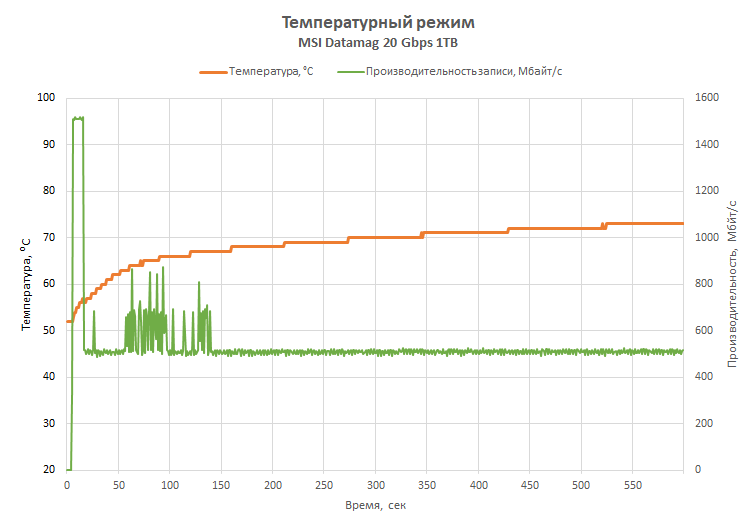
However, this does not affect the condition of the case at all – it is impossible to burn yourself on it. Since there is no contact between the chips underlying the Datamag 20Gbps and the outer shell, its external temperature does not exceed 43 degrees even under long-term loads.
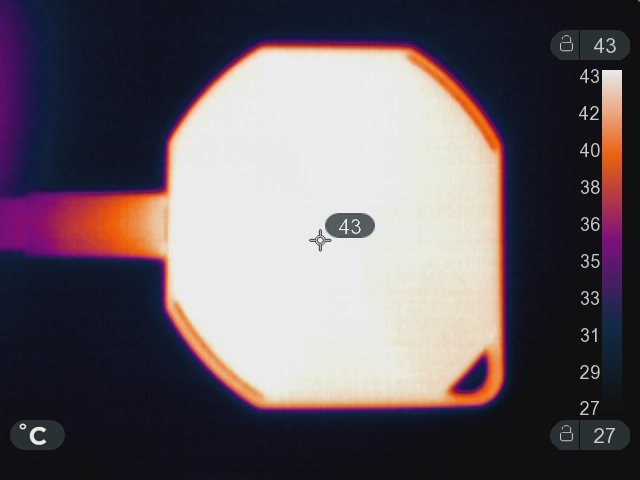
In other words, the drive may heat up significantly inside, but there is nothing to worry about. The controller temperature is kept within reasonable limits, and no throttling occurs.
⇡#Conclusions
Although the MSI Datamag 20Gbps is not a record-breaker, it is a fairly fast, reliable and practical portable SSD. It is perfect for transferring files between systems equipped with USB 3.2 Gen 2×2 and USB 3.2 Gen 2 ports, but not only for this. One of the advantages of the Datamag 20Gbps is its compatibility with a wide range of devices – it can be used not only with a PC, but also with tablets or smartphones, where it can simply expand the existing memory, for example when shooting high-resolution video.
However, Datamag 20Gbps reveals its full performance only in modern computers with high-speed USB ports. In this case, it can reach up to 1.6 Gbytes/s, which is quite comparable to the speed of inexpensive internal SSDs with a PCIe 3.0 interface – quite good for a USB drive. But even with the limited bandwidth of the port used, Datamag 20Gbps remains a very fast gadget that is unlikely to upset its owners.
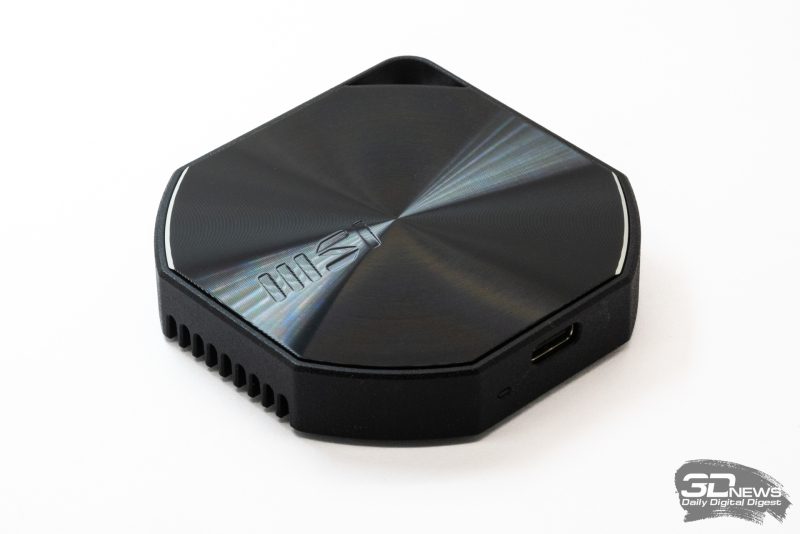
Separately, it is necessary to note the existence of an exclusive detail in Datamag 20Gbps – a magnetic base, thanks to which it can be attached both to any surfaces with magnetic properties and to pre-prepared non-magnetic surfaces (everything necessary for such preparation is included in the delivery set). This, of course, increases the convenience of the gadget, especially in those cases when it has to be used “on the run”.
Of course, it cannot be said that the MSI drive is completely free of drawbacks. I would like the MSI Datamag 20Gbps to be moisture and dust resistant, have a carabiner in the kit and have higher performance. However, we should not forget that the Datamag 20Gbps is just MSI’s first attempt at a new niche. It is obvious that in the future, external SSDs from this manufacturer will become better. But even now, the Datamag 20Gbps can be safely recommended for purchase: it has no obvious disadvantages, many advantages, and the favorable price and five-year warranty are quite strong additional arguments “for”.